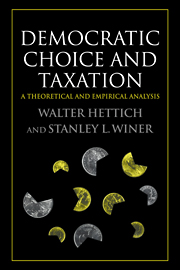Book contents
- Frontmatter
- Contents
- Preface
- 1 Introduction
- PART ONE THEORETICAL FRAMEWORK
- 2 Models of Political Economy and the Study of Taxation
- 3 Foundations of Democratic Tax Systems
- 4 Tax Structure in Equilibrium: A More Formal Model
- PART TWO COLLECTIVE CHOICE AND THE NORMATIVE ANALYSIS OF TAXATION
- PART THREE APPLIED GENERAL EQUILIBRIUM ANALYSIS
- PART FOUR STATISTICAL ANALYSIS OF TAX STRUCTURE
- PART FIVE POLITICAL INSTITUTIONS AND TAXATION
- Bibliography
- Name Index
- Subject Index
3 - Foundations of Democratic Tax Systems
Published online by Cambridge University Press: 08 October 2009
- Frontmatter
- Contents
- Preface
- 1 Introduction
- PART ONE THEORETICAL FRAMEWORK
- 2 Models of Political Economy and the Study of Taxation
- 3 Foundations of Democratic Tax Systems
- 4 Tax Structure in Equilibrium: A More Formal Model
- PART TWO COLLECTIVE CHOICE AND THE NORMATIVE ANALYSIS OF TAXATION
- PART THREE APPLIED GENERAL EQUILIBRIUM ANALYSIS
- PART FOUR STATISTICAL ANALYSIS OF TAX STRUCTURE
- PART FIVE POLITICAL INSTITUTIONS AND TAXATION
- Bibliography
- Name Index
- Subject Index
Summary
Why should public finance theory only be allowed to investigate the effects of various tax proposals, but not be permitted to analyze the factors which determine the form they take and the choice between different proposals which is then made by the political authorities? In both cases the question is one of clarifying factual causal relationships.
Eric Lindahl (1959, p. 8)It depends upon social structure and upon … political constellations whether … personal taxes or taxes on objects, income and profits taxes or land, investment, property and death taxes are to be chosen, whether the tax screw should be tightened or relieved, what groups of the population are to bear the heavier or the lighter burden, … whether expenditure is to be reduced or revenue raised, how taxation is to be combined with economic incentives, and so on.
Rudolf Goldscheid (1925, p. 207)Actual tax systems are complicated and often elaborate. Underneath their rather baroque appearance lies a simple skeleton, however, consisting of a limited number of parts. The main elements in all tax systems are tax bases, rate structures, and special provisions such as exemptions, credits, and deductions. A theoretical analysis of tax structure must explain how these elements arise as a result of private and public choices and also what determines their design and importance within the system as a whole.
- Type
- Chapter
- Information
- Democratic Choice and TaxationA Theoretical and Empirical Analysis, pp. 42 - 60Publisher: Cambridge University PressPrint publication year: 1999



